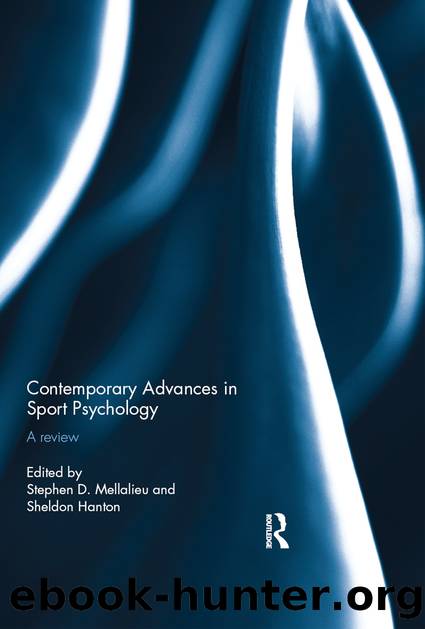Contemporary Advances in Sport Psychology by Unknown

Author:Unknown
Language: eng
Format: epub
ISBN: 1983451
Publisher: Routledge
Figure 5.5 The tripartite efficacy model.
Note
Arrows indicate predictive/associative relationships between tripartite efficacy constructs (positive in nature). Although relational efficacy beliefs are theorized to predominantly act as intra-relationship sources of self-efficacy (Lent and Lopez, 2002), dashed lines from self-efficacy to RISE/other-efficacy indicate that relational perceptions may also be shaped by individuals’ confidence in their own ability.
Existing proxy efficacy research highlights further support for the potential efficacy-enhancing properties associated with individuals’ confidence in another person’s capabilities. In particular, Bray and colleagues’ (Bray et al., 2001) cross-sectional analyses showed that fitness class attendees reported greater confidence in their own ability when they were highly confident in their exercise instructor. In a subsequent study, Bray and Cowan (2004) also demonstrated that when cardiac rehabilitation patients strongly endorsed the capabilities of their exercise consultant, this belief prospectively accounted for approximately 30 per cent of the variance in patients’ self-efficacy ratings when assessed approximately two months later. Within a college setting, further evidence for the predictive role of proxy efficacy in relation to self-efficacy was provided by Elias and Mac-Donald (2007), who reported that students were more confident in their own abilities when they believed that their faculty instructors were highly capable.
In order to further advance our understanding of the inter-relations that exist within the tripartite model, theoretically- and/or empirically-driven experimental manipulations are necessary (see, for example, Bray et al., 2013; Dunlop et al., 2011; Priebe et al., 2012) to identify causal pathways between efficacy beliefs. Most notably, although researchers to date have (justifiably) modeled RISE as a predictor of self-efficacy, Lent and Lopez (2002) noted that the relationship between self-efficacy and RISE is in fact likely to be bidirectional in nature. Indeed, there is ample evidence in the person perception literature for the process of projection, whereby individuals use their own self-views when attempting to infer the ways in which others view them (see Frey and Tropp, 2006; Kenny and DePaulo, 1993). With respect to the tripartite model it is possible that exercisers, for instance, might be guided by the way in which they appraise their own capabilities when estimating how confident their instructor is in their ability, particularly when they have insufficient interpersonal cues upon which to accurately gauge the other person’s thoughts (cf. Jussim et al., 1992). In light of this potentially recursive relationship, alongside experimental approaches we would encourage the use of cross-lagged (i.e. multiple time point) designs in future to allow for an examination of reciprocal relations, as well as research that examines the variables that might shape the direction of influence between self-efficacy and RISE (e.g. the level of experience that the perceiver has with the target). Although much is known regarding the wide-ranging affective and behavioural implications associated with self-efficacy (see Beauchamp et al., 2012; Feltz et al., 2008), such work would be invaluable in order to progress our knowledge of the way in which these self-views influence impression formation processes in social exchanges.
Download
This site does not store any files on its server. We only index and link to content provided by other sites. Please contact the content providers to delete copyright contents if any and email us, we'll remove relevant links or contents immediately.
The Inner Game of Tennis by W. Timothy Gallwey(3481)
Unstoppable by Maria Sharapova(3409)
Urban Outlaw by Magnus Walker(3250)
Crazy Is My Superpower by A.J. Mendez Brooks(3210)
Mind Fuck by Manna Francis(3041)
The Social Psychology of Inequality by Unknown(2774)
The Fight by Norman Mailer(2710)
Unstoppable: My Life So Far by Maria Sharapova(2388)
Accepted by Pat Patterson(2221)
Going Long by Editors of Runner's World(2217)
Futebol by Alex Bellos(2138)
The Happy Runner by David Roche(2129)
Motorcycle Man by Kristen Ashley(2118)
Backpacker the Complete Guide to Backpacking by Backpacker Magazine(2112)
The Sports Gene: Inside the Science of Extraordinary Athletic Performance by David Epstein(2064)
Sea Survival Handbook by Keith Colwell(2046)
Peak: Secrets from the New Science of Expertise by Anders Ericsson & Robert Pool(1928)
Endure by Alex Hutchinson(1874)
The Call of Everest by Conrad Anker(1789)
